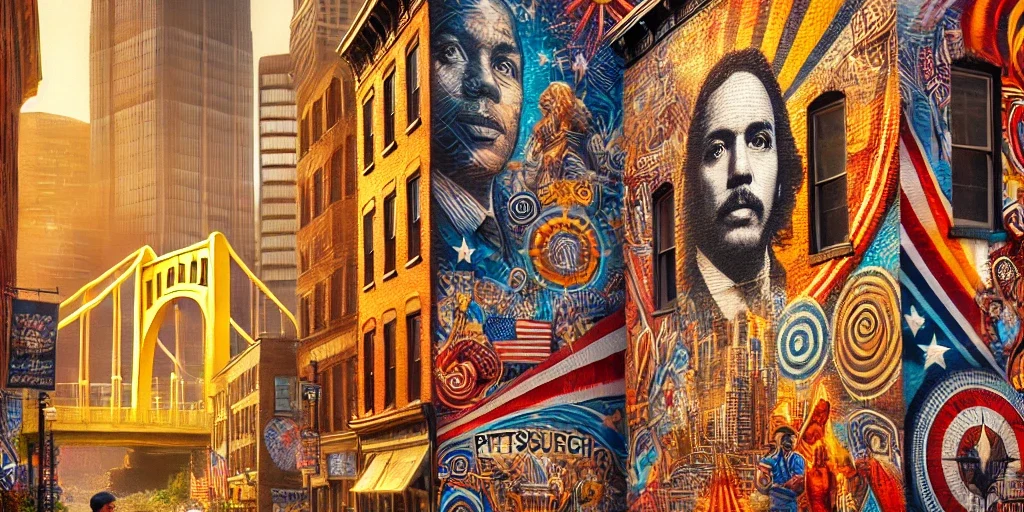Pittsburgh is a city built on steel and innovation, but its walls tell a story far beyond industry. In recent decades, Pittsburgh’s streets, bridges, and buildings have become a canvas for breathtaking murals and street art, transforming the city into an open-air gallery. From towering tributes to local legends to vibrant displays of cultural pride, these murals are more than just paint on brick—they are windows into the heart and soul of the Steel City. Here’s a look at some of the most iconic murals and street art that define Pittsburgh’s artistic landscape.
The Pittsburgh Parking Chair (South Side Flats)
If you’ve ever walked the South Side Flats, you’ve probably spotted this playful and quintessentially Pittsburgh mural. The Pittsburgh Parking Chair, painted by artist Jeremy Raymer, immortalizes the beloved (and controversial) tradition of using chairs to reserve street parking spots in the winter. The oversized, hyper-realistic depiction of a simple lawn chair speaks volumes about the city’s identity, humor, and sense of community.
The Randyland Murals (North Side)
No list of Pittsburgh street art would be complete without mentioning Randyland. Created by artist Randy Gilson, this explosion of color and creativity is one of the most famous public art spaces in the city. The walls of Randyland are a swirling mosaic of bright hues, playful patterns, and uplifting messages. It’s a beacon of positivity and a must-visit destination for art lovers and Instagram enthusiasts alike.
Roberto Clemente Mural (Downtown Pittsburgh)
A towering tribute to one of Pittsburgh’s most beloved sports heroes, the Roberto Clemente mural near PNC Park captures the essence of the legendary Pirates outfielder. Created by artist Jeremy Raymer, the mural showcases Clemente in action, his determination and grace frozen in time. More than just a baseball tribute, this artwork honors his legacy as a humanitarian who dedicated his life to helping others.
The History of Pittsburgh (Strip District)
Spanning an entire wall in the Strip District, The History of Pittsburgh Mural is a breathtaking visual timeline of the city’s past. This detailed masterpiece by muralist Richard Haas highlights key historical moments, from Pittsburgh’s industrial boom to its cultural and sports achievements. It’s a reminder of where the city has been and the resilience that continues to define it today. A few murals across the city also nod to Pittsburgh’s more shadowy past — from Prohibition-era bootleggers to mob lore — echoing the city’s notorious gangsters and crime stories that once shaped its streets.
Braddock’s Liberty Mural (Braddock Avenue)
Braddock, a town deeply tied to Pittsburgh’s steel history, is home to one of the most powerful pieces of street art in the region. The Liberty Mural, painted on the side of an old industrial building, is a striking commentary on labor, industry, and social justice. Featuring portraits of steelworkers and activists, this mural pays homage to the workers who built the region and the challenges they faced.
Two Andy Warhol Murals (The Strip District & North Side)
Pittsburgh’s most famous artist, Andy Warhol, is honored with not just one but two massive murals. The first, located in the Strip District, features Warhol’s iconic face in a vibrant pop-art style, a nod to his revolutionary impact on modern art. The second, on the North Side near The Andy Warhol Museum, is a more experimental piece that blends his classic silk-screen techniques with modern street art elements. Together, they serve as fitting tributes to the Pittsburgh-born king of pop art.
The Spirit of Jazz (Hill District)
The Hill District has long been a hub for Pittsburgh’s jazz scene, and The Spirit of Jazz Mural celebrates this legacy in vivid color. Featuring jazz legends like Mary Lou Williams and Art Blakey, the mural breathes life into the city’s rich musical past. It’s a stunning tribute to the rhythms and sounds that shaped generations of musicians in Pittsburgh.
The Pittsburgh Bridges Mural (East Liberty)
Pittsburgh is the city of bridges, and artist Kyle Holbrook captured their beauty in his sprawling Pittsburgh Bridges Mural. Located in East Liberty, this artwork weaves together images of the city’s famous yellow bridges, symbolizing connection, movement, and transformation. It’s a perfect representation of Pittsburgh’s constant evolution while staying true to its roots.
Moving Forward (Hazelwood)
One of the newer additions to Pittsburgh’s mural scene, Moving Forward in Hazelwood tells a story of resilience and renewal. This large-scale mural, created as part of a community revitalization effort, depicts scenes of Pittsburgh’s past and future, blending images of steel mills with futuristic cityscapes. It’s a striking reminder that Pittsburgh is always pushing ahead while respecting its history.
Conclusion: A City Painted with Stories
Pittsburgh’s murals are more than just artistic expressions—they are reflections of the city’s spirit. They capture the struggles, triumphs, and culture that define life in the Steel City. Whether you’re a lifelong Pittsburgher or just visiting, taking a tour of these iconic murals offers a glimpse into the city’s soul, one brushstroke at a time.









